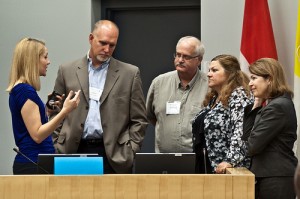“Going deeper,” was the phrase Kim McGill used when she described her PLP process last year. “Sometimes you lose sight of the big picture.”
Kim’s team was part of the Ontario cohort, from Avon Maitland where she serves as Curriculum Coordinator for Secondary Programs.
She also used the Prezi analogy of seeing more details the further one goes when describing her journey of exploring “big ideas.”

“That analogy fits here,” she said. “Until we explored this in-depth, with the support of PLP network, until we really got those deep pedagogical connections, we couldn’t see the big picture. Now there’s this holistic view. I don’t know if I would be here…I wouldn’t be in this place in my professional development…if I hadn’t participated.”
Kim, who had explored web tools for several years, was eager to work through the PLP process, as were the rest of the team members. But they discovered quickly how hard it was to collaborate.
“We didn’t gel as a team initially,” she said. There were a few growing pains as the team focused on how to work together. They decided to follow the PLP directive of not worrying about their classrooms and instead figuring out how to use online tools for personal use. That, and spending some time building a trusting relationship as they got to know one another, worked for them.
One teacher brought Google Docs to the team, and another created a Flickr account and joined the 365 group.”Through focusing on creating relationships first, we then were able to grow as a team,” she said. They started to regroup, realizing they shared the same goals and frustrations but more importantly, vision.
The Avon Maitland team centered on three issues for their project:
1) Creating guiding questions around teacher confidence and reluctant teachers
2) Being advocates of student voice: teachers learning alongside their students, and
3) Having the students teaching the teachers.
The project has been given the green light from the superintendent, so they know it will be running as a pilot next year. Their measure of success will be teacher and student surveys at end of school year to indicate how schools have been adopting technology integration. The team feels strongly they must look for the evidence and will be guided by that.
Kim’s team was excited on the culminating PLP day to share what they had learned.
“We thought we were pretty excited (with their own project), but to see what everyone else had done, well, we were so impressed to see all projects and inspired. We’re taking some of those ideas back too.”
We were “still learning on that last day–and wanting to continue on,” she said.
Kim shared a couple of videos her team made during the process. Take a look!
Latest posts by Powerful Learning Practice (see all)
- Hurry, you do not want to miss out on this… - November 3, 2020
- Resist the Urge to Quit Prematurely - October 26, 2020
- Let’s Move Past Feeling Disconnected from Your Students. Words Matter - October 24, 2020

